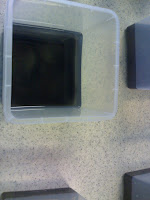




Pictures for the vitro vents requested.
Hello all, after reading the comments in my last post, I have decided to explain the different components of the media and I hope that everyone will understand better why the different components must be added.
MEDIA
Media components
The composition of the plant media is important for the plant media to grow properly. Plant tissue is usually made up of the following components: macronutrients, micronutrient, vitamins, amino acid or other nitrogen supplements, sugar(s), other undefined organic supplements, solidifying agents or support systems and growth regulators. For this post, I will be touching on macronutrients, micronutrients.
The media formulation that is used- Murashige and Skoog formulation contains the macronutrients and micronutrients. Macronutrients provide 6 major elements needed for plant growth: Nitrogen, Phosphorous, Potassium, Calcium, Magnesium and Sulfur. 25-60 mM of inoraganic nitrogen is needed in a culture for adequate plant growth. Potassium is needed for cell growth of plant species, most media have potassium in the nitrate, sulfate or choride form at concentration of 20-30 mM. The rest of the elements: Phosphorous, Magnesium, Sulfur and Calcium are included at concentrations ranging from 1-3 mM. Higher concentrations of these nutrients may be needed if dificiency of other nutrients are present. Micronutrients are elements such as Iron, Manganese, Zinc, Boron, Copper and Molybdenum. Chelated form of iron and zinc are commonly used, with Iron being very important. Iron citrate maybe used in culture media but the compounds are had to dissolve and usually precipitate out after media is done. Murashige and Skoog uses ethylene diaminetetraacetic acid-iron chelate to overcome this problem. Sodium and Chlorine are also used in some medium but are not essential for growth. Iron and Molybdenum are added at concentrations of 1 microM, Zinc at 5-30 microM, Manganese at 20-90 microM, Boron at 25-100 microM and Copper at 0.1 microM
4 comments:
HI
can you explain more on why the various macronutrients and micronutrients are required for plant growth?
Thanks alot.
Lim Xin Ni
TG02
Group 9
Hi Johan,
1 simple question...
What is the specific function of Molybdenum and boron in aiding plant growth?
Thankz!
Han Yang
TG01
Hi there,
whatever ure doing is interesting =) a qn for you...why is iron the most important nutrient?
Nur Farhana
0604834B
Hi peeps, sorry I took so long to reply again, here are your answers:
To Xin Ni: (Macronutrients) Nitrogen is a big component of proteins, hormones, chlorophyll, vitamins and enzymes important for plant life. Phosphorus is necessary for photosynthesis, formation of protein and almost all aspects of growth and metabolism.Potassium is necessary for formation of sugars, starches, carbohydrates, synthesis of protein and cell division in roots and other parts of the plant. Sulfur is a structural component of amino acids, proteins, vitamins and enzymes and is needed in chlorophyll production. Magnesium is a critical structural component of the chlorophyll molecule and is needed for functioning of plant enzymes to produce carbohydrates, sugars and fats. Calcium activates enzymes, it is a structural component of cell walls and is necessary for cell growth and division.
(Micronutrients)Manganese is involved in enzyme activity for photosynthesis, respiration, and nitrogen metabolism. Iron is necessary for many enzyme functions and as a catalyst for the synthesis of chlorophyll. Boron is necessary for cell wall formation, membrane integrity and uptake of calcium. Zinc is a component of enzymes or a functional cofactor of a large number of enzymes including plant growth hormones. Copper is concentrated in roots of plants and plays a part in nitrogen metabolism. Molybdenum is a structural component of the enzyme that reduces nitrates to ammonia.
To Han Yang: Boron is needed for cell wall formation, membrane integrity and uptake of calcium.
Molybdenum is a structural component of the enzyme that reduces nitrates to ammonia,
synthesis of protein cannot occur without it.
To Farhana: Because Iron is necessary for many enzyme functions and it is also necessary for the synthesis of chlorophyll(iron is a catalyst)
Post a Comment